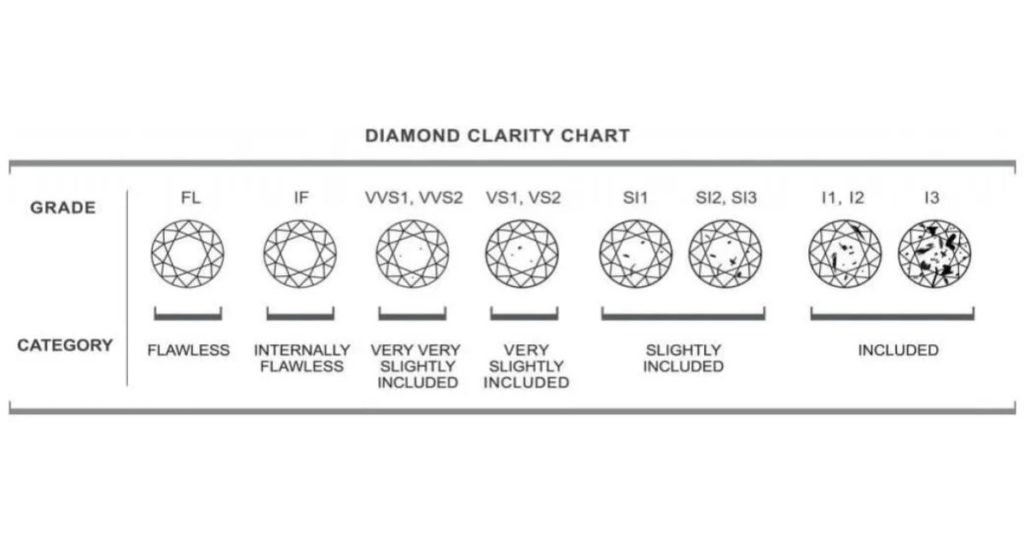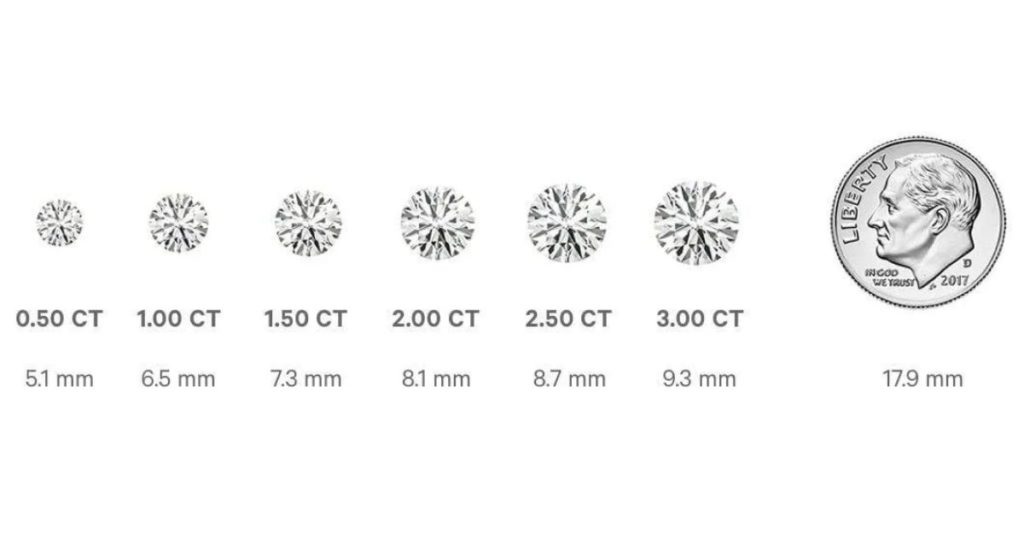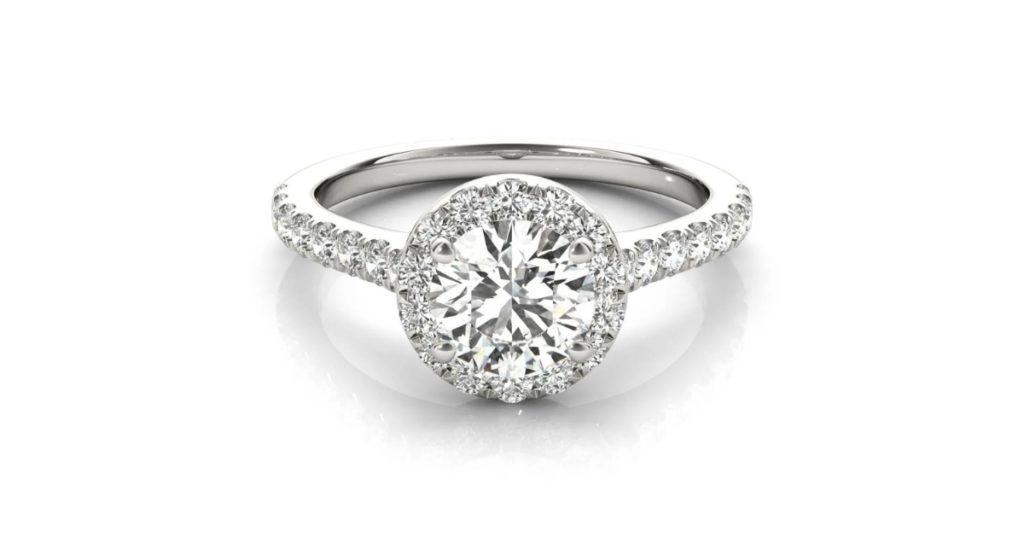An engagement ring marks one of life’s most significant milestones – the moment you commit to your partner forever. Buying an engagement ring deserves careful thought and consideration, but it doesn’t have to be daunting either. That’s why we created this guide on how to choose an engagement ring that uniquely captures your love story. We’ll discuss how to select the perfect diamond based on the 4Cs, customize a setting that reflects your style, and buy a ring that aligns with your values. By the end, you’ll have the knowledge to choose a show-stopping ring your partner will cherish for a lifetime. Let’s begin this exciting journey to find the perfect symbol of your love and commitment.
The 4Cs of Diamond Quality
When choosing the perfect engagement ring, understanding the 4Cs of diamond quality is crucial. These four factors significantly impact the appearance, value, and overall brilliance of your ring’s center stone.
Cut

The cut of a diamond refers to its proportions, symmetry, and polish, all of which determine how well the diamond interacts with light. A well-cut diamond will exhibit incredible sparkle and fire. Consider cut as the diamond’s personality – it’s what gives it that dazzling allure. At Clean Origin, all of our diamonds rate at, or above, a “Good” level. This ensures the diamond you choose will add sparkle and shine to the ring.
Clarity

Diamonds often contain natural imperfections known as inclusions and blemishes. Clarity measures the number and size of these imperfections. A higher clarity grade means fewer and smaller flaws, resulting in a more flawless and valuable diamond. Any blemishes or inclusions are only visible to diamond experts using a jeweler’s loupe. Because of this, Clean Origin offers diamonds only graded S12 and above.
Color

Diamonds come in a vast range of colors, from completely colorless to various shades of yellow or brown. The Gemological Institute of America (GIA) grades diamonds on a scale ranging from D (colorless) to Z (light yellow or brown). The less color a diamond exhibits, the higher its value will be. Clean Origin only offers diamonds that receive a grade of J-D on the color scale
Carat Weight

Carat weight refers to the size of the diamond. While carat weight is often associated with a diamond’s size, it’s essential to balance this with the other 4Cs. A larger diamond may have a lower value if it has lower cut, clarity, or color grades. Consider carat weight with the other Cs to find the right balance for your engagement ring.
Understanding these four aspects of diamond quality is the foundation for selecting a diamond that will impress and delight your future spouse.
Different Diamond Shapes and Styles
The perfect diamond shape and engagement ring style is a highly personal choice. It’s an opportunity to express your partner’s unique personality and preferences.
Diamond Shapes

Diamonds come in various shapes, each with its own distinct charm and character. Some of the most popular diamond shapes include:
- Round: A round diamond, also known as a round brilliant cut diamond, is a classic and timeless choice known for its exceptional brilliance.
- Princess: A square-shaped diamond with pointed corners, offering a modern and elegant look.
- Cushion: A square or rectangular shape with rounded corners, known for its vintage appeal.
- Emerald: Rectangular with cut corners, showcasing the diamond’s clarity and elegant lines.
- Oval: An elongated, elliptical shape that offers a unique and flattering appearance.
- Marquise: A boat-shaped diamond with pointed ends, creating a striking and regal look.
- Pear: Resembling a teardrop, it combines the features of both round and marquise shapes.
- Heart: Heart-shaped diamonds are a romantic choice, symbolizing love and devotion.
Engagement Ring Styles

In addition to the diamond shape, consider the setting of your engagement ring. Engagement ring styles encompass a wide range of designs, from classic to modern and everything in between. Some popular styles include:
- Solitaire: A single diamond as the centerpiece, emphasizing the beauty of the diamond.
- Halo: A central diamond surrounded by a halo of smaller diamonds, adding extra sparkle.
- Vintage: Vintage rings have intricate, detailed designs reminiscent of past eras.
- Three-Stone: Featuring three diamonds, symbolizing the past, present, and future.
- Modern/Contemporary: Sleek, minimalist designs with clean lines and unique settings.
- Nature-Inspired: Rings with organic and nature-themed elements, perfect for nature lovers.
Consider how the chosen engagement ring style will complement your wedding bands. Whether you opt for a classic solitaire engagement ring or a vintage-inspired design, ensuring that it pairs seamlessly with your wedding rings is essential for creating a cohesive and harmonious bridal set.
Selecting the Right Metal for the Ring
The choice of metal for your diamond ring band is a significant decision that influences the overall look and feel of the ring. Different metals offer various aesthetics, durability, and maintenance requirements. Let’s explore some popular metals for engagement rings:
Yellow Gold

Yellow gold is a timeless and traditional choice for engagement ring bands. It’s known for its warm, rich color that complements a wide range of diamond shapes and styles. Yellow gold engagement rings have a classic and elegant appeal, making them popular for those who appreciate tradition.
White Gold

White gold offers a brilliant, silvery-white finish that beautifully complements the sparkle of diamonds. It’s a versatile choice that pairs well with classic and modern ring designs. White gold engagement rings are known for their contemporary and sophisticated look.
Rose Gold

Rose gold, with its romantic and blush-pink hue, has gained popularity in recent years. It adds a touch of warmth and uniqueness to engagement ring designs. Rose gold rings are perfect for individuals who appreciate a vintage or romantic aesthetic.
Platinum

Platinum is a rare, durable metal known for its white, lustrous appearance. It’s hypoallergenic and highly resistant to tarnish and wear, making it an excellent choice for those with sensitive skin or an active lifestyle. Platinum engagement rings are known for their durability and timeless beauty.
Finding the Perfect Ring Size

Ensuring the right fit for your engagement ring is as crucial as choosing the right diamond and metal. If you’re planning a surprise proposal, consider discreetly asking close friends or family members for their insights on your partner’s ring size. They may have valuable information or be able to help you find out without spoiling the surprise. If your partner currently wears rings, borrow one that is worn on the same finger you intend to place the engagement ring. A jeweler can use this ring as a reference for determining the appropriate size.
Professional Sizing
Visit a reputable jeweler to have your partner’s finger professionally measured. It’s important to note that fingers can fluctuate in size due to factors like temperature and time of day, so it’s best to get measured at a few different times to ensure accuracy. Many jewelers, including Clean Origin, offer online ring sizing tools and guides that can help you find an accurate size based on a variety of factors.
If you’re unsure about the exact size, consider selecting a slightly larger size. Many rings can be resized if needed. However, be aware that certain settings and styles may be more difficult to resize, so it’s important to consult with a jeweler before making a final decision.
Lab Grown Diamonds: The Ethical And Environmentally Friendly Alternative

In recent years, lab grown diamonds have emerged as a compelling alternative to natural diamonds. These gems are created in controlled environments, mimicking the natural diamond-forming process. Choosing lab grown diamonds offers several advantages:
Ethical Considerations
One of the major ethical concerns of natural diamonds is the issue of “blood” diamonds. These diamonds are often mined in conflict zones and used to finance armed conflicts against governments. By choosing lab grown diamonds, you can be confident that your purchase does not contribute to unethical practices.
Environmental Impact
Natural diamond mining has a significant environmental footprint. It involves the removal of large quantities of Earth, energy consumption, and the release of greenhouse gases. Lab grown diamonds, on the other hand, have a substantially smaller environmental impact. They are created with minimal disturbance to the Earth’s ecosystems and reduce the carbon footprint associated with diamond mining.
Certification and Documentation

When selecting an engagement ring, particularly one with a diamond, it’s crucial to prioritize certification and documentation. These aspects ensure that you are making an informed and trustworthy purchase.
Importance of Diamond Certification
Diamond certification is a formal assessment of a diamond’s quality and characteristics conducted by an independent gemological laboratory. The Gemological Institute of America (GIA) and the International Gem Society (IGS) are the most recognized and respected laboratories for diamond grading. Certification provides the following benefits:
- Quality Assurance: A certified diamond has been thoroughly examined, allowing you to know its exact quality, including the 4Cs (cut, clarity, color, and carat weight).
- Value Assessment: Certification helps determine the diamond’s market value, ensuring you get what you pay for.
- Comparison: With a certified diamond, you can easily compare it to other diamonds and make an informed decision.
- Resale Value: A certified diamond may have a higher resale value in the future due to its documented quality.
Certificates for Lab Grown Diamonds
Lab grown diamonds also come with a diamond grading report from reputable gemological laboratories, just like natural diamonds. These certificates provide detailed information about the diamond’s quality and origin, ensuring transparency in the purchase.
Engagement Ring Shopping at Clean Origin

Skip the chaos of crowded mall jewelers. With us, you can browse a breathtaking selection of ethically sourced diamond rings easily online, right from your home.
We empower you to shop with confidence every step of the way. Expert guidance and education are always available through virtual appointments with our diamond specialists. They’re happy to answer any questions and provide recommendations tailored to your style and budget.
If you’d like to view our lab grown diamond jewelry in person, we welcome you to schedule a relaxing, personalized visit at one of our nearby locations.
From online to in-store, we make finding your ideal engagement ring stress-free and fun. Our goal is to ensure you walk away with a ring that captures the essence of your love story.



